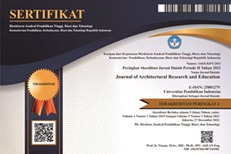Understanding of Environmental Architecture in The Development of Campus II of Darunnajah Al-Islamy Junior High School, Kepil, Wonosobo
Abstract
Kepil Wonosobo area is a region that has the potential for developing sustainable environmental architecture. This study aims to evaluate the implementation of environmental architecture principles in Kepil Wonosobo, identify the challenges faced, and provide recommendations for improving environmental architecture practices in the region. One of the projects in the Kepil area is the Development of Campus II of SMP Darunnajah Al-Islamy. Development projects need to prioritize aspects of environmental architecture so that development does not damage the environment. This study will reveal the understanding of environmental architecture of the actors in the development of Campus II of SMP Darunnajah Al-Islamy Kepil Wonosobo. The research method used is a survey of a combination of primary and secondary data. Primary data were obtained through direct observation and interviews with relevant stakeholders, while secondary data were obtained through literature studies and available information about environmental architecture projects in Kepil Wonosobo. The survey results show that awareness of environmental architecture in Kepil Wonosobo already exists, with the majority of respondents stating a good understanding of its principles. Several projects have implemented environmental architecture principles, such as the use of environmentally friendly materials, energy efficiency, water management, and attention to green open spaces. However, there are still challenges in implementation, including awareness and education that need to be improved as well as limited resources.
Keywords
Full Text:
PDFReferences
Ahad, M. A., Paiva, S., Tripathi, G., & Feroz, N. (2020). Enabling technologies and sustainable smart cities. Sustainable Cities and Society, 61(March), 102301. https://doi.org/10.1016/j.scs.2020.102301
Ashour, M., Mahdiyar, A., Haron, S. H., & Hanafi, M. H. (2022). Barriers to the practice of sustainable interior architecture and design for interior renovations: A Parsimonious-Cybernetic Fuzzy AHP approach. Journal of Cleaner Production, 366(December 2020), 132958. https://doi.org/10.1016/j.jclepro.2022.132958
Attia, A. S. (2020). Traditional multi-story house (Tower House) in Sana’a City, Yemen. An example of sustainable architecture. Alexandria Engineering Journal, 59(1), 381–387. https://doi.org/10.1016/j.aej.2020.01.001
Boarin, P., & Martinez-Molina, A. (2022). Integration of environmental sustainability considerations within architectural programmes in higher education: A review of teaching and implementation approaches. Journal of Cleaner Production, 342(February), 130989. https://doi.org/10.1016/j.jclepro.2022.130989
Brambilla, A., & Sangiorgio, A. (2020). Mould growth in energy efficient buildings: Causes, health implications and strategies to mitigate the risk. Renewable and Sustainable Energy Reviews, 132(July), 110093. https://doi.org/10.1016/j.rser.2020.110093
Giuzio, G. F., Russo, G., Forzano, C., Del Papa, G., & Buonomano, A. (2024). Evaluating the cost of energy flexibility strategies to design sustainable building clusters: Modelling and multi-domain analysis. Energy Reports, 12(July), 656–672. https://doi.org/10.1016/j.egyr.2024.06.047
Hermawan, Faqih, N., Sunaryo, & Svajlenka, J. (2023). Prediction of Particulate Matter (PM) Concentration of Wooden Houses in the Highlands by Two Statistical Modelling Methods. International Journal on Advanced Science, Engineering and Information Technology, 13(5), 1628–1634. https://doi.org/10.18517/ijaseit.13.5.18361
Hermawan, H., & Švajlenka, J. (2021). The connection between architectural elements and adaptive thermal comfort of tropical vernacular houses in mountain and beach locations. Energies, 14(21). https://doi.org/10.3390/en14217427
Muazir, S., & Lestari, L. (2019). Built Environment Impact To Microclimate (Air Temperature). DIMENSI (Journal of Architecture and Built Environment), 46(1), 23–34. https://doi.org/10.9744/dimensi.46.1.23-34
Peeters, A. L., van der Werff, E., & Tromp, N. (2022). Designing for value-behaviour consistency: ethical choice architecture to stimulate sustainable meat purchase. Cleaner and Responsible Consumption, 5(March), 100067. https://doi.org/10.1016/j.clrc.2022.100067
Prasad, R., Tandon, R., Verma, A., Sharma, M., & Ajmera, N. (2022). Jaali a tool of sustainable architectural practice: Understanding the feasibility and usage. Materials Today: Proceedings, 60, 513–525. https://doi.org/10.1016/j.matpr.2022.01.424
Pre-proofs, J., Wang, Y., Dong, Q., Guo, H., Yin, L., Gao, W., & Yao, W. (2023). Indoor Thermal Comfort Evaluation of Traditional Dwellings in Cold Region of China : A Case Study in Guangfu Ancient City. Energy & Buildings, 113028. https://doi.org/10.1016/j.enbuild.2023.113028
Soussi, Y., Bahi, H., Mastouri, H., & El Bouazouli, A. (2023). An embedded concept for sustainable building. Materials Today: Proceedings, 72, 3556–3563. https://doi.org/10.1016/j.matpr.2022.08.307
Švajlenka, J., Kozlovská, M., & Mokrenko, D. (2021). Mgo-based board materials for dry construction are a tool for more sustainable constructions—literature study and thermal analysis of different wall compositions. Sustainability (Switzerland), 13(21). https://doi.org/10.3390/su132112193
van Ellen, L. A., Bridgens, B. N., Burford, N., & Heidrich, O. (2021). Rhythmic Buildings- a framework for sustainable adaptable architecture. Building and Environment, 203, 108068. https://doi.org/10.1016/j.buildenv.2021.108068
Widera, B. (2021). Comparative analysis of user comfort and thermal performance of six types of vernacular dwellings as the first step towards climate resilient, sustainable and bioclimatic architecture in western sub-Saharan Africa. Renewable and Sustainable Energy Reviews, 140, 110736. https://doi.org/10.1016/j.rser.2021.110736
DOI: https://doi.org/10.17509/jare.v7i1.76009
Refbacks
- There are currently no refbacks.
Copyright (c) 2025 Journal of Architectural Research and Education

This work is licensed under a Creative Commons Attribution-NonCommercial-ShareAlike 4.0 International License.

This work is licensed under a Creative Commons Attribution-ShareAlike 4.0 International License.








